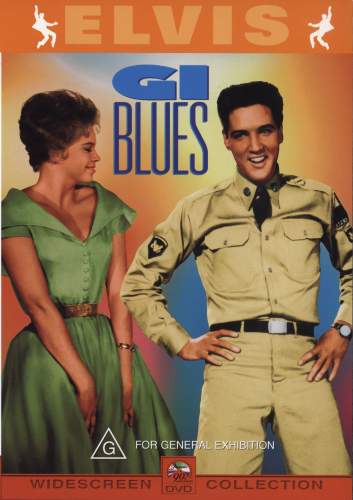G.I. Blues (1960) |
|
G.I. Blues (1960) |
|


|
| BUY IT |
| General | Extras | ||
| Category | Romantic Comedy | Theatrical Trailer | |
| Rating |

|
||
| Year Of Production | 1960 | ||
| Running Time | 99:36 | ||
| RSDL / Flipper | No/No | Cast & Crew | |
| Start Up | Language Select Then Programme | ||
| Region Coding | 4 | Directed By | Norman Taurog |
|
Studio
Distributor |
 Paramount Home Entertainment |
Starring |
Elvis Presley Juliet Prowse |
| Case | ? | ||
| RPI | $39.95 | Music | None Given |
| Video | Audio | ||
| Pan & Scan/Full Frame | None |
English Dolby Digital 5.1 (448Kb/s) German Dolby Digital 2.0 mono (192Kb/s) French Dolby Digital 2.0 mono (192Kb/s) Spanish Dolby Digital 2.0 mono (192Kb/s) Italian Dolby Digital 2.0 mono (192Kb/s) English Dolby Digital 2.0 mono (192Kb/s) |
|
| Widescreen Aspect Ratio | 1.78:1 | ||
| 16x9 Enhancement |
 |
||
| Video Format | 576i (PAL) | ||
| Original Aspect Ratio | 1.85:1 | Miscellaneous | |
| Jacket Pictures | No | ||
| Subtitles |
English German French Spanish Italian Dutch Swedish Danish Norwegian English for the Hearing Impaired German for the Hearing Impaired |
Smoking | No |
| Annoying Product Placement | No | ||
| Action In or After Credits | No | ||
Another in the Paramount series of Elvis Presley films, G.I. Blues sees a case of art imitating life with The King playing American Serviceman Tulsa McLean. He is stationed in Frankfurt, Germany in 1960 and when he's not driving around in a tank on exercises blowing things up, he likes to make music and sing love songs. Together with a couple of mates, Tulsa croons around the base and tries to scrape together some spare cash playing a bar or two. His dream is to open his own nightclub when his tour is over and he finally makes it home to Okalahoma. Of course he needs the money to help fund his dream, but the wages from playing the clubs are quite small, so he decides to gamble a little and accepts a wager from fellow servicemen. The bet seems quite easy, especially for someone as smooth and debonair as Tulsa. All he needs to do is spend the night with dancer Lili (Juliet Prowse) from the local nightclub. Unfortunately for Tulsa, this girl is known as possibly the coldest and most unapproachable girl in the city and has never let any man even remotely near her. But this doesn't stop Tulsa, and he soon embarks on a mission to win the heart of the girl and pocket the wager as well. Of course, if true love were to take its course...well I don't need to say anymore.
This is typical Elvis fare. There are lots of songs, hammy acting, the King crooning and schmaltzing his way through every scene and damsels all swooning over him. It was quite unusual to watch this in a time slot other than a Sunday afternoon, and to tell the truth I quite enjoyed it. The quality of the video transfer probably assisted my enjoyment.
This transfer took me a little by surprise. It is remarkably sharp, vibrant, and only suffers from some noticeable film artefacts. Not bad for a forty year old film.
Presented in an aspect ratio of 1.78:1 (which is almost the same as the theatrical release of 1.85:1), the transfer is also thankfully 16x9 enhanced.
As I said, this is a superb transfer of a film that is more than forty years old. It is mostly sharp throughout with only the odd scene or two a little softer than I would like. There is no edge enhancement present. Grain is evident only on the lower quality projected backgrounds and for some of the wider angle second unit shots that occur outside. There is also no low level noise.
The colours really shine and are well saturated with solid and even depth. Skin tones tend to be a little red at times, and there is some distinct chroma noise on the red background during the bar scene at 11:30 and the purple background at 72:05. Other than that there are few problems.
There are no MPEG artefacts. Film to video artefacts are completely absent (a very, very nice surprise). The only negative is that there are numerous film artefacts, and though most are really not of any major size, there are a handful that are quite prominent. I also noticed a couple of reel change markings at 47:02 and 122:43 that were rather obvious.
Several subtitle options are present. The English variety are present in a decent size typeface that is easy to read, and while not being completely accurate, will more than suffice for the job.
Despite what the packaging says this is a single sided/single layer disc only, so there is no layer change to contend with.
| Sharpness | |
| Shadow Detail | |
| Colour | |
| Grain/Pixelization | |
| Film-To-Video Artefacts | |
| Film Artefacts | |
| Overall |
Now this is how I like my audio soundtracks presented for older films. We get a remastered Dolby Digital 5.1 track AND the original mono soundtrack (it has been restored according to the packaging, but still retains all its mono glory).
There are six audio tracks on this disc. The remastered Dolby Digital 5.1 track is joined by Dolby Digital 2.0 Mono tracks in French, Italian, Spanish, German, and Restored English. I listened to the Dolby Digital 5.1 track in its entirety. While it may say 5.1 channels on the display of my amplifier, this is pretty much a front and centre soundtrack with all but a few sound effects in the music coming from the left and right channels.
Dialogue is front and centre, and while exhibiting little in the way of dynamic range, is clear and prominent. There are no audio sync problems with the dialogue, but there are certainly some obvious syncing issues during the songs, where it is glaringly obvious that all are mimed.
There is plenty of music on offer (naturally) as Elvis croons his way through nearly a dozen of them.
There is virtually no surround channel or subwoofer use. The soundtrack really doesn't call for it anyway.
| Dialogue | |
| Audio Sync | |
| Clicks/Pops/Dropouts | |
| Surround Channel Use | |
| Subwoofer | |
| Overall |
This appears to the be the original 1960s trailer, featuring a cheesy American voiceover and just about showing every major scene and plot spoiler in its 2:35 minute running time. Shown in the aspect ratio of 1.78:1, it is also 16x9 enhanced, though the quality is not as good as the film. I strongly advise against watching this before the film.
NOTE: To view non-R4 releases, your equipment needs to be multi-zone compatible and usually also NTSC compatible.
Looks like both discs are similarly specified. Have to lean to the Region 4 disc for price and PAL formatting considerations.
G.I. Blues is certainly not going to stretch the old grey matter too far, but it doesn't set out to. It's a bit of harmless fun that any Elvis fan will absolutely enjoy from start to finish.
The video quality is excellent, even more remarkable for the age of the source material.
The remastered Dolby Digital 5.1 soundtrack is nothing spectacular, but does the job with a minimum of fuss.
The extra is very lonely all by itself.
| Video | |
| Audio | |
| Extras | |
| Plot | |
| Overall |
| Review Equipment | |
| DVD | Loewe Xemix 5106DO, using RGB output |
| Display | Loewe Calida (84cm). Calibrated with Video Essentials. This display device is 16x9 capable. |
| Audio Decoder | Built in to amplifier/receiver. Calibrated with Video Essentials. |
| Amplification | Harmon/Kardon AVR7000. |
| Speakers | Front - B&W 602S2, Centre - B&W CC6S2, Rear - B&W 601S2, Sub - Energy E:xl S10 |